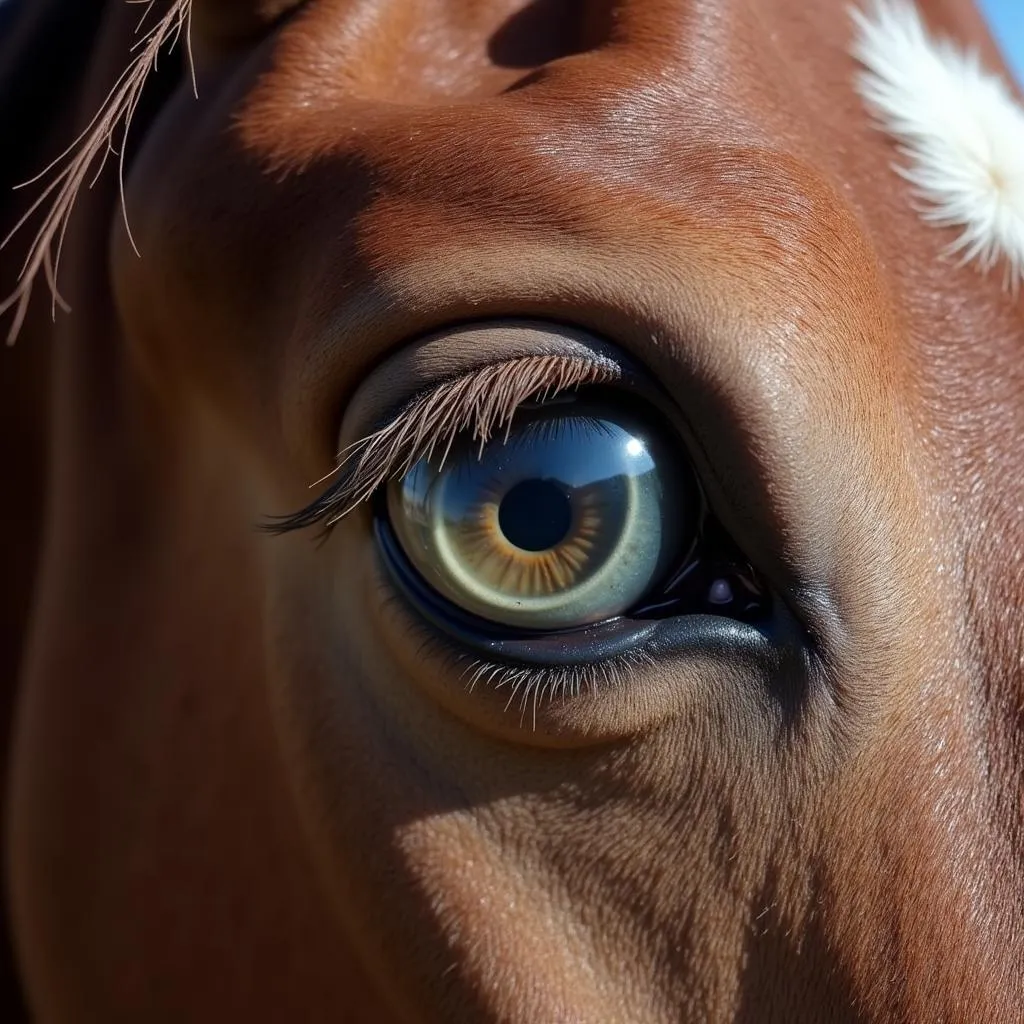Horses are prey animals with a strong flight response, making good eyesight essential for their survival in the wild. However, just like humans, horses can experience various eye problems throughout their lives. Understanding common Horse Eyesight Problems, their symptoms, and available treatments is crucial for any horse owner. Early detection and intervention can significantly impact your equine companion’s long-term health and well-being.
Common Horse Eyesight Problems
A range of conditions can affect a horse’s vision, from minor irritations to severe, sight-threatening diseases. Here are some of the most common horse eyesight problems:
1. Equine Recurrent Uveitis (ERU)
Often called “moon blindness,” ERU is an inflammatory condition affecting the uvea, the middle layer of the eye. This potentially blinding disease can cause recurring episodes of pain, redness, tearing, squinting, and cloudiness in the eye.
2. Corneal Ulcers
Corneal ulcers are open sores on the cornea, the clear outer layer of the eye. They can result from trauma, such as a scratch from a branch, or infections. Signs of a corneal ulcer include excessive tearing, squinting, cloudiness, and a visible wound or defect on the cornea.
 Horse eye with corneal ulcer
Horse eye with corneal ulcer
3. Cataracts
Cataracts occur when the lens of the eye becomes cloudy, impairing vision. While they can be present at birth (congenital), cataracts often develop with age. Signs of cataracts in horses include a bluish-white discoloration in the pupil, difficulty seeing in low light, and clumsiness.
4. Conjunctivitis
Commonly known as “pink eye,” conjunctivitis is an inflammation of the conjunctiva, the thin, transparent membrane lining the eyelids and covering the white part of the eye. It can be caused by bacteria, viruses, or irritants like dust and pollen. Symptoms include redness, swelling, discharge, and squinting.
 Horse displaying conjunctivitis symptoms
Horse displaying conjunctivitis symptoms
5. Equine Herpesvirus (EHV)
Certain strains of EHV, particularly EHV-1 and EHV-4, can cause eye problems in horses. These viruses can lead to conjunctivitis, corneal ulcers, and even uveitis. Symptoms can range from mild to severe and may include fever, lethargy, and neurological signs.
Recognizing the Signs: When to Contact Your Vet
Early detection of horse eyesight problems is crucial for successful treatment. If you notice any of the following signs in your horse, contact your veterinarian immediately:
- Excessive tearing: More tears than usual, especially if accompanied by other symptoms.
- Squinting: Holding the eye partially or completely closed, indicating pain or discomfort.
- Cloudiness: Any haziness, discoloration, or change in the appearance of the cornea or pupil.
- Redness: Inflammation and redness in the white part of the eye or the conjunctiva.
- Discharge: Watery, thick, yellow, or green discharge from the eye.
- Swelling: Swelling around the eye, eyelids, or surrounding tissues.
- Light sensitivity: Increased sensitivity to light, often accompanied by squinting.
- Changes in behavior: Head shyness, clumsiness, reluctance to move, or changes in normal behavior.
 Veterinarian performing an eye exam on a horse
Veterinarian performing an eye exam on a horse
Diagnosing and Treating Horse Eyesight Problems
Diagnosing eye problems in horses requires a comprehensive eye exam by a qualified veterinarian. They will assess your horse’s vision, examine the structures of the eye, and potentially perform diagnostic tests like a fluorescein stain to detect corneal ulcers.
Treatment for horse eyesight problems varies depending on the underlying cause and severity of the condition. It may include:
- Medications: Antibiotics, antiviral medications, anti-inflammatory drugs, or pain relievers.
- Topical treatments: Eye drops or ointments to treat infections, reduce inflammation, or relieve pain.
- Surgery: In some cases, surgery may be necessary to repair damage, remove cataracts, or address other eye conditions.
Protecting Your Horse’s Eyesight
Prevention is always better than cure. Here are some tips to help protect your horse’s eyesight:
- Regular veterinary checkups: Schedule annual or biannual eye exams, especially for older horses or those with a history of eye problems.
- Safe environment: Ensure your horse’s environment is free of hazards that could cause eye injuries, such as protruding nails, sharp branches, or loose fencing.
- Fly control: Flies can spread eye infections, so implement effective fly control measures in and around your horse’s stable and pastures.
- Proper nutrition: Feed a balanced diet that supports overall health, including eye health.
- Early intervention: If you notice any signs of eye problems, contact your veterinarian immediately.
Conclusion
Horse eyesight problems can be a serious concern, potentially impacting your horse’s quality of life and even their safety. By understanding common conditions, recognizing the signs, and seeking prompt veterinary care, you can help protect your equine companion’s precious gift of sight. Remember, early detection and intervention are key to successful treatment and a positive outcome for your horse.
If you have any concerns about your horse’s eyesight, please don’t hesitate to contact us. Call us at 0772127271, email us at [email protected], or visit us at QGM2+WX2, Vị Trung, Vị Thuỷ, Hậu Giang, Việt Nam. Our dedicated team is available 24/7 to assist you with any questions or emergencies.